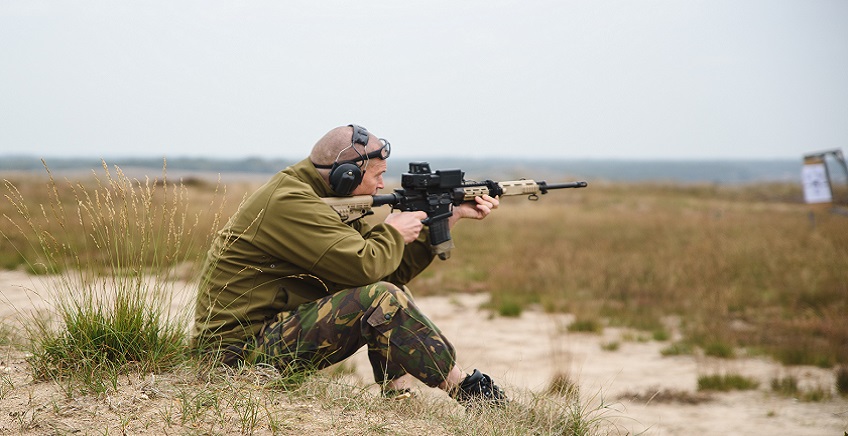Above: A Dutch soldier during the drills. Source: Dutch Ministry of Defence
The US Army and the Royal Netherlands Army recently conducted live trainings examining the Smash 2000 Fire Control System of Smart Shooter from Kibbutz Yagur (near Haifa). The system is mounted on small arms, and zeroes in on the target using AI-based image processing to assist the soldier to shoot more accurately. The US Army tested the system by firing on ground targets, while the Dutch army tested its drone-interception capabilities using small arms. Both armies characterized the exercises as successful.
The Dutch exercise was carried out at a military facility in the town of Harde (Netherlands), with the participation of combat soldiers from the air force, navy, and the special forces. As part of the exercise, they were equipped with Colt rifles which were outfitted with Smart Shooter’s Fire Control System, in order to test whether it allows infantry soldiers to eliminate low flying drones using their personal weapons.
The soldiers fired at drones of various types and sizes from a distance of up to 165 yards. The company stated that all targets were eliminated. The Dutch Ministry of Defence has also issued an official announcement about the experiment, seemingly hinting at the strategic importance it assigns to the system. Smart Shooter estimated that the success of the two trials constitutes a significant milestone in introducing the solution to the world’s leading armies.
Small arms take down a drone
Dr. Abraham Mazor, VP of Marketing and Development at Smart Shooter, told Techtime that the exercise is the result of four years of working together with the Dutch army. “The Dutch army has examined the functioning of the system in its operational scenarios and in accordance with the threats it faces. The exercise was defined as a success according to the criteria they set. I believe it will lead to the acquisition of the system”. According to Mazor, “The simplicity of the system stood out no less than its accuracy. The soldiers arrived without prior experience, and after a short instruction of several minutes were able to take down drones.”

Drone interception using small arms is one of the key scenarios which interest armies around the world. Recently, the US Department of Defense (DoD) incorporated the system in the Counter Small Unmanned Aerial Systems (C-sUAS) program. Mazor: “Our system provides a response to this new kind of threat. There are many systems that know how to take care of drones. However, there is no system that allows a soldier to independently intercept a drone without supporting systems such as a remote radar.”
“The existing systems are based on disrupting drones by electronic means. In the future, drones will be autonomous, without a communication unit or GPS, and in a formation of a drone fleet, and therefore electronic warfare will be less effective. Militaries understand that, and some are considering the possibility that in every combat platoon there will be a trained soldier who can intercept drones.”
The rifle ceases to be a “Statistical Weapon”
Smart Shooter was founded by two former members of Rafael’s missile division, CEO Michal Mor and CTO Avshalom Erlich. It has developed the Smash Fire Control System to be mounted on top of every assault rifle using a rail. The system zeroes in on the target using electro-optical sensors and monitors it using AI-based image processing algorithm.

An automatic tracking allows the soldier to aim effortlessly, and when the weapon is positioned at the right angle – the trigger is released automatically. Mazor: “Smart Fire Control Systems will become an integral element in all modern combat perceptions. The rifle cannot continue to remain a statistical weapon. We upgrade the level of infantrymen to the world of missiles: at the technological level, in the perception, and in production and assembly.”
Jumping targets within 440 yards
The exercise conducted by the United States Army took place during September 14-24 at the APG training facility in Aberdeen, Maryland. During the exercise, the soldiers were equipped with assault rifles which were outfitted with Smart Shooter’s Fire Control System and fired thousands of magazines at stationary, moving, and jumping targets at ranges of 25-440 yards. At the end of the exercise, the accuracy rates were compared to those typical of using standard sights.
The exercise was funded and supervised by the Army Combat Capabilities Development Command. Smart Shooter is currently active in about 15 countries, mostly through subsidiaries or local representatives (in the US and Germany), as well as through collaborations with security contractors such as Thales in Australia, TBM in the Netherlands, and Opto S&D of the Akaer Group in Brazil. “We are in the midst of a very extensive marketing activity, which includes demonstrations and procurements.”

